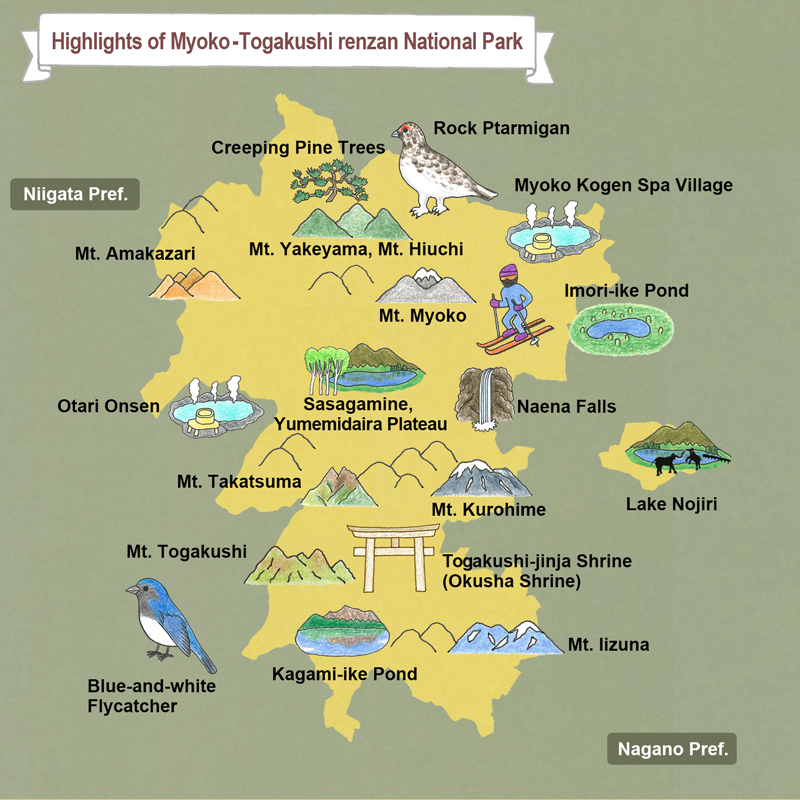- MOE
- National Parks of Japan
- Myoko-Togakushi renzan National Park
- Guide of Highlights
main body
Highlights of Myoko-Togakushi renzan National Park
Hokushingogaku
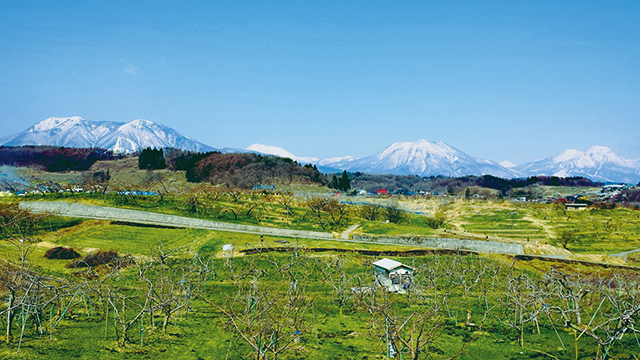
Hokushingogaku
Collectively called the Hokushingogaku, a group of Mt. Myoko, Mt. Kurohime, Mt. Togakushi, Mt. Iizuna and Mt. Madarao (outside the park) has been loved by people since the days of old. These mountains boast of different histories and forms where visitors can enjoy from various angles.
Mt. Amakazari
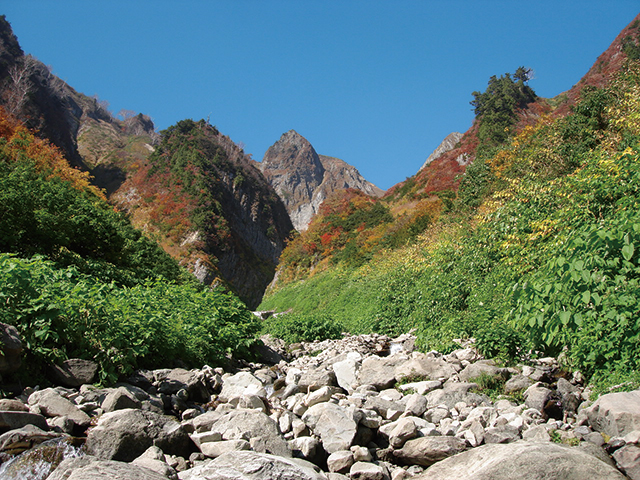
Crimson Foliage of the Mt. Amakazari
(From the mid to end of October)
(From the mid to end of October)
Mt. Amakazari
Listed as one of the Nihon Hyakumeizan (hundred famous mountains in Japan), visitors can enjoy a commanding view of the Sea of Japan and North Alps at the top. The foot of the mountain is famous for the beautiful crimson foliage adding colors to Kama Pond. Visitors can relieve their fatigue in a natural hot spring after descending the mountain.
Mt. Yakeyama

Mt. Yakeyama
Located in the west of Niigata Prefecture. An active volcano (2,400 m above sea level) issuing steam at the northern limit of the fossa magna belt. Straddles the border between Itoigawa City and Myoko City in Niigata Prefecture. The Kubiki Sanzanrefers collectively to Mt. Myoko, Mt. Hiuchi, and Mt. Yakeyama.
Mt. Hiuchi

Mt. Hiuchi
One of the hundred mountains of Japan (2,462 m above seal level), located across the borders of Itoigawa City and Myoko City in Niigata Prefecture. Koyaike is a vast high moor located at approximately 2,100 m above sea level, noted for changing vegetation (e.g., cotton-sedge, red leaves of fall) through the seasons. Noted as Japan's northernmost rock ptarmigan colony.
Myoko Kogen Spa Village

Myoko Kogen Spa Village
The Myoukou Kogen Spa Village located in the southwest of Niigata Prefecture includes seven hot spring sites, with five hot spring water qualities, and three hot spring colors. Of these, Tsubameonsen is located at the highest altitude (approximately 1,100 m above sea level). Characterized by a milky white colored hot spring. Open-air baths such as Kawaranoyu are also popular.
Otari Onsen
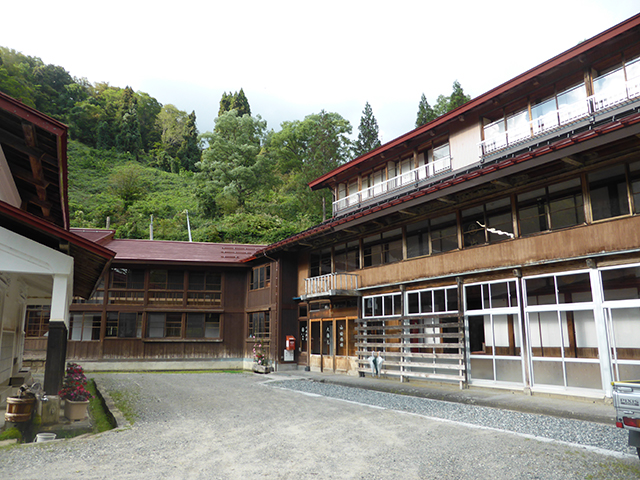
Otari Onsen
The Otari Onsen, which is said to be discovered by a liegeman of Takeda Shingen, is a famous natural hot spring for its history of over 450 years.
Kagami-ike Pond
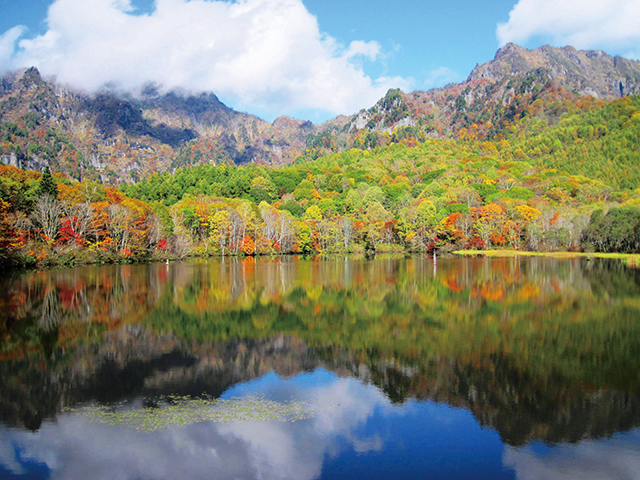
Crimson Foliage of the Kagami-ike Pond
(From the mid to end of October)
(From the mid to end of October)
Kagami-ike Pond
Boasting a panoramic view of the Togakushi Mountain Range, a row of the mountains are reflected in the surface of the pond to exhibit breathtaking sceneries. The lingering snow in the spring and the sceneries of crimson foliage are the must-see sights.
Togakushi-jinja Shrine
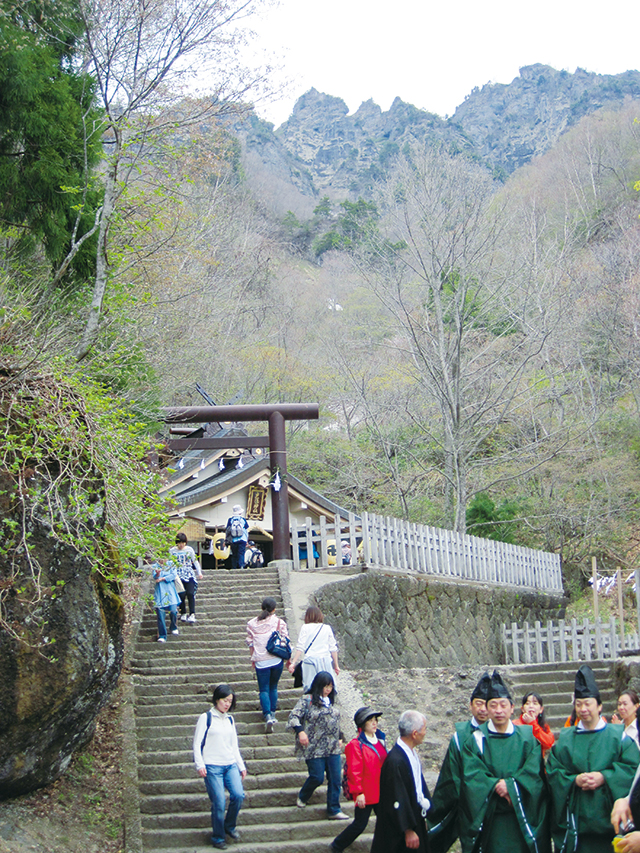
The Togakushi-jinja Okusya Shrine and Mt. Togakushi
Togakushi-jinja Shrine
The Togakushi-jinja Shrine is a collective name of five shrines: the Okusha Shrine, Kuzuryusha Shrine, Chusha Shrine, Hinomikosha Shrine and the Hokosha Shrine. It enshrines the legendary Amano-Iwato gods and the guardian god of Togakushi.
Togakushi Soba Noodles

Bocchi Mori
Togakushi Soba Noodles
The periphery of the Togakushi Highland is a famous region for planting soba (buckwheat) flowers and the streets are lined with many restaurants serving soba noodles. The noodles here are arranged on a flat basket by a bite-sized portion, called Bocchi Mori, which is peculiar to the region.

The Fields of Soba (Buckwheat) Flowers and
the Togakushi Mountain Range
the Togakushi Mountain Range
Sasagamine / Yumemidaira Plateau
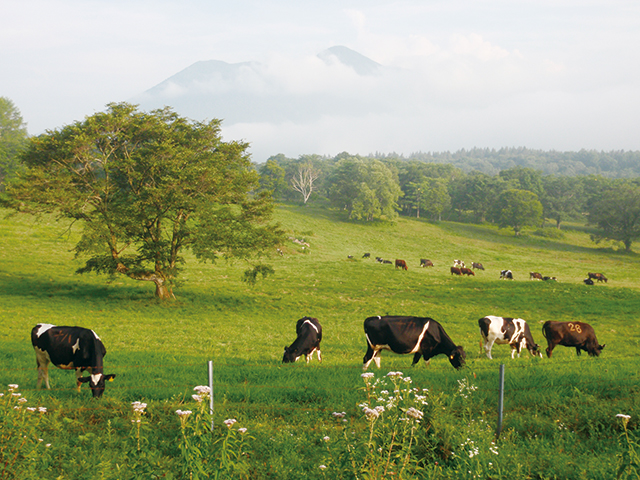
Sasagamine Farm
Sasagamine / Yumemidaira Plateau
Besides the rich natural forests, Sasagamine gives a glimpse of people's involvement such as stock farms and dams along with its history. It offers well-developed nature trails that lead to these sites and visitors can enjoy camping and trekking there.
Naena Falls
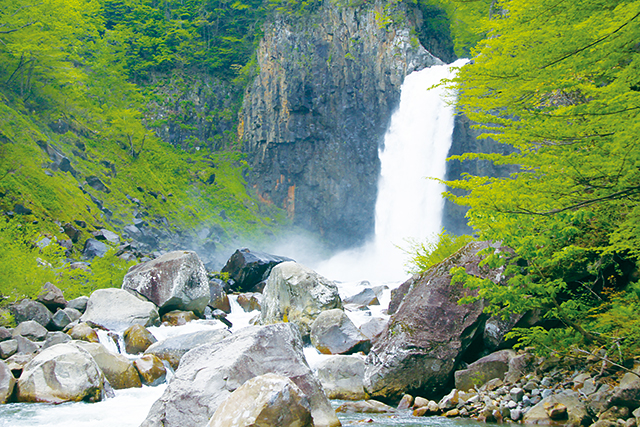
Naena Falls (Summer)
Naena Falls
Located on the boundaries of Myoko City in Niigata Prefecture and Shinano Town in Nagano Prefecture. Selected as one of the top 100 Japanese waterfalls. The view of the spray of water rising from a columnar jointed rock wall is breathtaking. The volume of water increases with the snow melt in spring, enhancing the views.
Imori-ike Pond
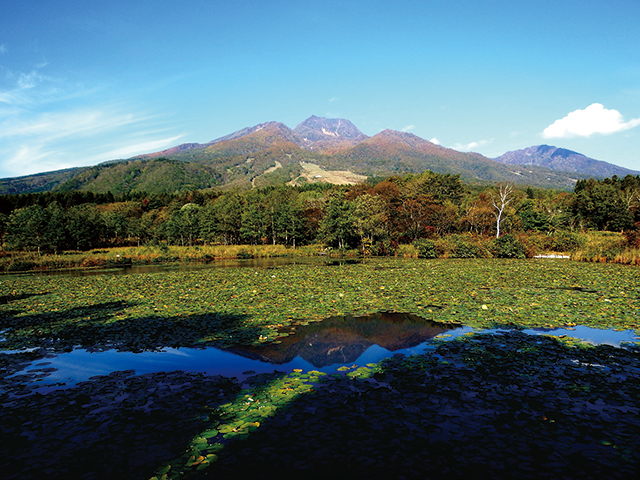
Imori-ike Pond and the Mt. Myoko
Imori-ike Pond
Having 500 meters in circumference, the pond located in the IkenoTaira Onsen is a site to see a commanding view of Mt. Myoko, making it an excellent place to enjoy observing the nature and magnificent sceneries all year around. The Asian skunk cabbage that blooms in spring is especially famous.
Ski Resort
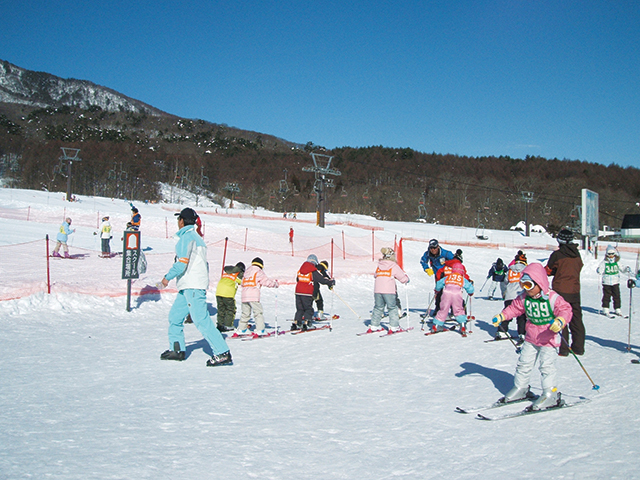
Ski Resort and Skiers in the Winter
Ski Resort
This area is also best known as a heavy snowfall area. For that reason, there are many ski resorts that are visited by a host of skiers during winter.
Lake Nojiri

A Statue of a Naumann Elephant (The Lakeside
of Lake Nojiri)
of Lake Nojiri)
Lake Nojiri
Besides being famous for the unearthed fossils of Naumann Elephant, the lake is a destination for fishing and water sports.
Mt. Iizuna

Mt. Iizuna
A mountain (1,917 m above sea level) extending across the boundaries of Nagano City, Shinano Town and Iizuna Town in the north of Nagano Prefecture. One of the five mountains of Hokushin. Known as the subject of mountain worship since ancient times. Now well-known as a mountain for beginner mountaineers.
Wildlife & Plants
Creeping Pine Trees (Pinus pumila)

Creeping Pine Trees (Pinus pumila)
On the peaks and ridgelines of the Kubiki Sanzan, and Mt. Kanayama and Mt. Takatsuma within this park, clusters of Siberian Dwarf pine can be found at altitudes of less than 2,500 m above sea level due to the effects of the plentiful snow from the Japan Sea.
Blue-and-white Flycatcher (Cyanoptila cyanomelana)
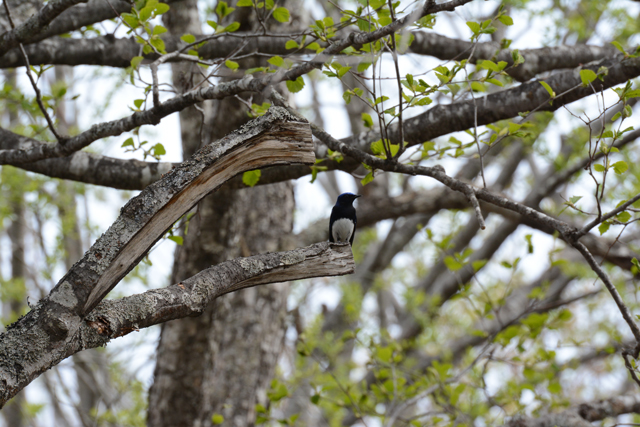
Blue-and-white Flycatcher (Cyanoptila cyanomelana)
These birds visit Japan in summer to reproduce, and are found in hilly and mountainous areas up to the sub-alpine zone. Often seen in forests alongside mountain streams. Characterized by beauty in both form and call, they are one of the three top songbirds of Japan.
Rock Ptarmigan (Lagopus mutus japonicus)

Rock Ptarmigan (Lagopus mutus japonicus)
Rock ptarmigan found in the area around Mt. Hiuchi are the northernmost population in Japan. This population is found at low altitudes and is therefore susceptible to the effects of climate change. Since the population is small, there is the fear that it may become extinct.
Activities
Skiing
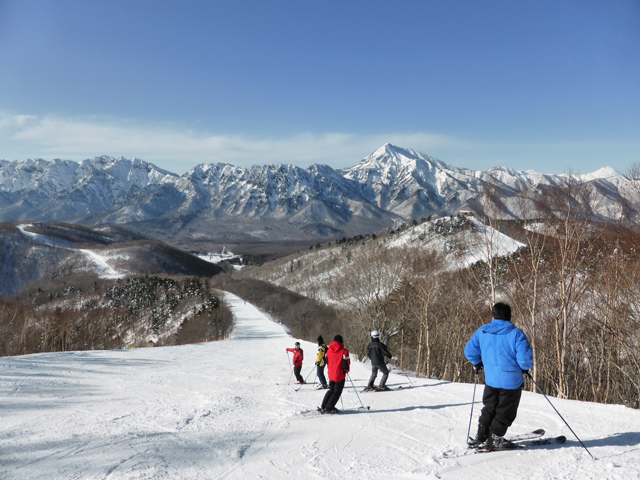
Skiing
This park is one of the few in Japan located in a region of heavy snowfall. It supports many skiing spots (e.g., Myoukou Highland, Akakura Hot Springs, Togakushi, Kurohime Highland, Iizuna Highland) and is visited by large numbers of tourists.
